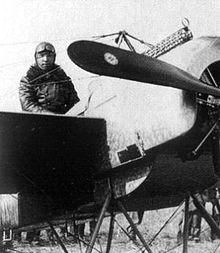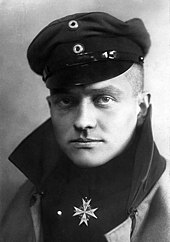Luftstreitkräfte: Difference between revisions
→Aircraft designation system: clarity |
oh, what pov editoralizing |
||
| Line 151: | Line 151: | ||
See [[List of World War I flying aces]] |
See [[List of World War I flying aces]] |
||
[[File:Manfred von Richthofen.jpg|thumb|upright|left| |
[[File:Manfred von Richthofen.jpg|thumb|upright|left|[[Manfred von Richthofen]], best known as "The Red Baron".]] |
||
The fighters, however, received the most attention in the annals of military aviation, since it produced high-scoring "aces" such as [[Manfred von Richthofen]], popularly known in English as "The Red Baron" (in Germany, he was known as "''der Rote Kampfflieger''" [Red Air Fighter]), [[Lothar von Richthofen]], [[Ernst Udet]], [[Hermann Göring]], [[Werner Voss]], the master aerial tactician [[Oswald Boelcke]] and [[Max Immelmann]] (the latter pair of aces were the first to be awarded the ''[[Pour le Mérite]]'', Imperial Germany's highest decoration for gallantry: simultaneously, on January 12, 1916.) The award to Immelmann very possibly caused the revered decoration to acquire its popular nickname, the "Blue Max". |
The fighters, however, received the most attention in the annals of military aviation, since it produced high-scoring "aces" such as [[Manfred von Richthofen]], popularly known in English as "The Red Baron" (in Germany, he was known as "''der Rote Kampfflieger''" [Red Air Fighter]), [[Lothar von Richthofen]], [[Ernst Udet]], [[Hermann Göring]], [[Werner Voss]], the master aerial tactician [[Oswald Boelcke]] and [[Max Immelmann]] (the latter pair of aces were the first to be awarded the ''[[Pour le Mérite]]'', Imperial Germany's highest decoration for gallantry: simultaneously, on January 12, 1916.) The award to Immelmann very possibly caused the revered decoration to acquire its popular nickname, the "Blue Max". |
||
==Insignia== |
==Insignia== |
||
Revision as of 21:15, 12 February 2017
| Deutsche Luftstreitkräfte | |
|---|---|
 Form of Cross Pattée used on German military aircraft in 1915 | |
| Founded | 1910 – 8 May 1920 |
| Country | |
| Allegiance | |
| Branch | German Army |
| Type | Air force |
| Size | In 1918: 2,709 front line aircraft 56 airships 186 balloon detachments About 4,500 flying personnel |
| Engagements | World War I Greater Poland Uprising (1918-1919) |
| Commanders | |
| Notable commanders | Hermann von der Lieth-Thomsen Ernst von Hoeppner |
| Insignia | |
| 1914–1915 |  |
| 1916 – March 1918 |  |
| March/April 1918 to 1919 |  |
The Deutsche Luftstreitkräfte (German: [ˈdɔʏtʃə ˈlʊftˌʃtʁaɪtkʁɛftə], German Air Force)—known before October 1916 as the Fliegertruppen des deutschen Kaiserreiches (Imperial German Flying Corps)[1] or simply Die Fliegertruppe—was the World War I (1914–18) air arm of the German Army, of which it remained an integral part. In English-language sources it is usually referred to as the Imperial German Air Service, although that is not a literal translation of either name. German naval aviators serving with the Marine-Fliegerabteilung remained an integral part of the Imperial German Navy (Kaiserliche Marine). Both military branches, the army and navy, operated conventional aircraft, observation balloons and Zeppelins.
Founding
The first military aircraft to be acquired by the German Army entered service in 1910 – forming the nucleus of what was to become the Luftstreitkräfte in October 1916. The duties of such aircraft were initially intended to be reconnaissance and artillery spotting in support of armies on the ground, just as balloons had been used during the Franco-Prussian War of 1870–1871 and even as far back as the Napoleonic Wars. For comparison, France's embryonic army air service (Aviation Militaire), which eventually became the Armée de l'Air, was instituted later in 1910 – the Air Battalion of the Royal Engineers (later re-organised as the Royal Flying Corps) was not formed until November 1911.
Organization
The initial units of the Luftstreitkräfte, dedicated to observation, were known as Feldflieger Abteilungen (Field Flier Detachments), and had an official establishment of six unarmed, two-seat "A" and/or "B"-class aircraft apiece, with each "FFA" unit assigned to an army unit in their local area, and usually numbered with the same number as the army they were assigned to serve.
The Luftstreitkräfte organization changed substantially as the war progressed, to accommodate and adapt to the new types of aircraft, doctrine, tactics and the needs of the ground troops, in particularly the artillery. During this time the system of organisation and unit designations evolved that would form the basis of those used in the Third Reich's Luftwaffe when it was revealed in 1935.
During 1916, the German High Command, in response to Allied air superiority, reorganized their forces by creating several types of specialist units, most notably single-seat fighter squadrons, or Jagdstaffeln (literally "hunting squadron"), in order to counter the offensive operations of the Royal Flying Corps and the French Aviation Militaire.
Fighter unit organization

The initial deployment of fighter aircraft in the summer of 1915 occurred within the Feldflieger Abteilung, which were being equipped with one or two of the new Fokker Eindecker fighter aircraft for each unit, starting with the five Fokker M.5K/MG production prototypes of the Eindecker, bearing serial numbers E.1/15 through E.5/15. The buildup of the Eindecker fighter force rapidly progressed with regular lMG 08 "Spandau"-armed production examples of the Fokker E.I following the deliveries of the M.5K/MG airframes late in the summer of 1915, with early E.Is going to aces like Max Immelmann, who received IdFlieg serial number E.13/15 in August 1915.
The first step towards specialist fighter-only aviation units within the German military was the establishment of Kampfeinsitzer Kommando (single-seat battle unit, abbreviated as KEK) formations by Inspektor-Major Friedrich Stempel in February 1916. These were based around Eindeckers and other new fighter designs emerging, like the Pfalz E-series monoplanes, that were being detached from their former FFA units during the winter of 1915–1916 and brought together in pairs and quartets at particularly strategic locations, as KEK units were formed at Vaux, Avillers, Jametz, Cunel and other strategic locations along the Western Front, to act as Luftwachtdienst (aerial guard force) units, consisting only of fighters.[2]
Following the era of the KEK units through the summer of 1916, Jagdstaffeln (hunting squadrons), established by the reorganization that started by the late summer of 1916 were fielded by four kingdoms of the German Empire. Individually - each of these units was often known by the abreviation "Jasta". The Kingdom of Prussia was predominant, with a fighter force eventually comprising 67 squadrons. The Kingdom of Bavaria formed ten of these units, the Kingdom of Saxony formed seven and the Kingdom of Württemberg four.
On 24 June 1917, the Luftstreitkräfte brought a quartet of Jasta squadrons together to form its first fighter wing, Royal Prussian Jagdgeschwader I, incorporating Jastas 4, 6, 10 and 11, and set the pattern for using Roman numerals in the Luftstreitkräfte for designating such larger-sized units. Manfred von Richthofen was moved up from command of Jasta 11 to command JG I. Much as Jasta 2 had been renamed as Jasta Boelcke in December 1916 after Oswald Boelcke, Germany's top fighter tactician had been lost in a mid-air collision in October 1916, following the "Red Baron's" death in action in late April 1918, JG I was renamed to honor von Richthofen by order of the Kaiser.[3][4]
The Prussians established three more Jagdgeschwader. On 2 February 1918, JG II formed from Jastas 12, 13, 15 and 19, with Adolf Ritter von Tutschek in command.[5] On the same day, JG III consolidated Jasta 2 Boelcke and Jastas 26, 27 and 36 under Bruno Loerzer.[6] Finally, on 2 September 1918, the Royal Prussian Marine Jagdgeschwader was formed from the Kaiserliche Marine's Marine Feld Jastas I through V and placed in charge of Gotthard Sachsenberg. Bavaria established the Royal Bavarian Jagdgeschwader IV on 3 October 1918, from Jastas 23, 32, 34 and 35 under Eduard Ritter von Schleich.[7]
Unit designations

- (AFA) Artillerieflieger-Abteilung: Artillery Flier Detachment
- (AFS) Artillerieflieger-Schule; Artillery Flier School
- AFP – Armee-Flug-Park: Army Flight Park
- BZ – Ballonzug: Balloon Platoon
- BG – Bombengeschwader: Bomber Wing
- Bogohl – the "Bombengeschwader der Oberste Heeresleitung", the bombing wings under direct control by the German Army's High Command in World War I.
- Bosta – Bomberstaffel: Bomber Squadron
- etc – Etappe: Post
- FFA – Feldflieger Abteilung: Field Flier Detachment, the initial flight formations of the German Army in 1914–15
- FLA – Feldluftschiffer-Abteilung: Field Airship Detachment
- FestFA – Festungsflieger-Abteilung: Fortress Flier Detachment
- FA – Flieger-Abteilung: Flier Detachment
- FA(A) – Flieger-Abteilung (Artillerie): Flier Detachment (Artillery)
- FlgBtl – Flieger-Bataillon: Flier Battalion
- FBS – Fliegerbeobachter-Schule: Aerial Observer School
- FEA – Fliegerersatz-Abteilung: Replacement Detachment
- FS – Fliegerschule: Flight School
- JG – Jagdgeschwader: Fighter wing
- Jasta – Jagdstaffel: Hunting group", i.e., Fighter Squadron
- JastaSch – Jagdstaffel-Schule: Fighter Squadron School (also referred to as Jastaschule)
- KEK – Kampfeinsitzerkommando: Combat Single-Seater Command, a predecessor to Jasta units
- Kest – Kampfeinsitzerstaffel: Combat single-seater squadron, a predecessor to Jasta units
- KG – Kampfgeschwader: tactical bomber wing
- Kagohl – the "Kampfgeschwader der Oberste Heeresleitung", the tactical bomber wings under direct control by the German Army's High Command in World War I.
- Kasta – Kampfstaffel: tactical bomber squadron
- Luft – Luftschiff-Truppe: Airship force
- LsBtl – Luftschiffer-Bataillon: Airship battalion
- RBZ – Reihenbildzug: Aerial photography platoon
- Rfa – Riesenflugzeug-Abteilung: Giant Aircraft Detachment
- Schlasta – Schlachtstaffel: attack squadron
- Schusta – Schutzstaffel: Protection squadron
Aircraft




During the war, the Imperial Army Air Service utilised a wide variety of aircraft, ranging from fighters (such as those manufactured by Albatros-Flugzeugwerke, Fokker, Pfalz Flugzeugwerke and Siemens-Schuckert), reconnaissance aircraft (Aviatik, DFW and Rumpler), two-seat fighters from both Halberstädter Flugzeugwerke and Hannoversche Waggonfabrik; and heavy bombers, largely the twin-engined designs from the Gothaer Waggonfabrik firm, better known as Gotha, and the enormous, multi-engined heavy bombers produced by the Zeppelin-Staaken firm, and rigid airships from both the Zeppelin firm and Schütte-Lanz as well as various types of airships from other firms.
Aircraft designation system
During the First World War German aircraft officially adopted for military service were allocated a designation that included (1) the name of the manufacturer, (2) a function or "class" letter, and (3) a Roman numeral. The three-part designation was needed for a unique designation to simplify logistics support of the many types of aircraft in operation – especially as Luftstreitkräfte squadrons more often than not were equipped with several different types.
The designation system evolved during the war. Initially all military aircraft were classed as "A" (monoplane) or "B" (biplane). The new "C" class of armed (two seat) biplane began to replace the "B" class aircraft as reconnaissance machines in 1915, the B's continuing to be built, but as trainers. The "E" class of armed monoplane were also introduced in 1915 – the other classes being added later as new aircraft types were introduced. For most of the war 'D' was only used for biplane fighters, 'E' for monoplane fighters and 'Dr' for triplane fighters. By the end of the war however, the 'D' designation was used for all single-seat fighters, including monoplanes (and, in theory at least, triplanes).
- A – Unarmed reconnaissance monoplane aircraft (for example the Rumpler Taube and Fokker M.5)
- B – Unarmed two-seat biplane, with the observer seated in front of the pilot.
- C – Armed two-seat biplane, with the observer (usually) seated to the rear of the pilot.
- CL – Light two-seater (primarily from Halberstadt and Hannover), initially intended as escort fighters – by 1917–18, mainly used for ground attack.
- D – Doppeldecker – single-seat, armed biplane, but later any fighter – for instance the Fokker E.V monoplane was redesignated the D.VIII.
- Dr – Dreidecker – triplane fighter (prototype Fokker triplanes initially "F")
- E – Eindecker – armed monoplane – initially included monoplane two-seaters. New monoplane types at the end of the war designated as "D" (single seat) or "CL" (two seat).
- G – Grosskampfflugzeug – Large twin-engined types, mainly bombers (initially "K")
- GL – Lighter, faster twin-engined bombers, intended for use by day.
- J – Schlachten – Fuel tanks, pilot, and (usually) the engine protected by armour plate, reducing vulnerability to ground fire. Used for low-level work, especially ground attack.
- N – "C" type aircraft adapted for night bombing – apart from night flying equipment they were fitted with wings of greater span to increase bomb load.
- R – Riesenflugzeug – "Giant" aircraft – at least three, up to four or five engines – all serviceable in flight.
Most manufacturers also had their own numbering systems quite separate from the official military designations for their products. These sometimes cause confusion – for instance the military "J" series of armored aircraft designs was quite distinct from the Junkers aviation firm's own "J" factory type designations – the factory designation of the (military) Junkers J.I armored, all-metal sesquiplane, for example, was the Junkers J.4.[8] The "M" (for "Militär" or military) and "V" (for "Versuchs" or experimental, according to some source initially Verspannungslos or "unbraced") designations of the Fokker firm were also internal. The latter has no direct connection with the official Third Reich-era German "V" designation, also signifying "versuchs", for prototype aircraft, promulgated by the RLM from 1935.
The Kaiserliche Marine's Marine-Fliegerabteilung maritime aviation service used manufacturers' designations rather than the systematic Luftstreitkräfte system described above. For example, the landplane Gotha bombers were numbered in an "LD" (for "land biplane") series by their manufacturer, but in the "G" series in the Luftstreitkräfte – while the Gotha seaplanes used by the navy were (and continue to be) known by their manufacturer's "WD" (for Wasserflugzeug-Doppeldecker, or "seaplane biplane") designation. Similarly, the sizable number of German seaplane designs from the Flugzeugbau Friedrichshafen, were all known in naval service by their "FF" factory designations.
Army and Navy airships were individually numbered, in the same way as contemporary German destroyers and submarines, and were outside any system of "type" designation.
Pilots
See List of World War I flying aces

The fighters, however, received the most attention in the annals of military aviation, since it produced high-scoring "aces" such as Manfred von Richthofen, popularly known in English as "The Red Baron" (in Germany, he was known as "der Rote Kampfflieger" [Red Air Fighter]), Lothar von Richthofen, Ernst Udet, Hermann Göring, Werner Voss, the master aerial tactician Oswald Boelcke and Max Immelmann (the latter pair of aces were the first to be awarded the Pour le Mérite, Imperial Germany's highest decoration for gallantry: simultaneously, on January 12, 1916.) The award to Immelmann very possibly caused the revered decoration to acquire its popular nickname, the "Blue Max".
Insignia

Initially all German and Austro-Hungarian military aircraft in service used the Cross Pattée insignia, most often known in German as the Eisernes Kreuz, for the well-known Prussian military medal. The Balkenkreuz, a black Greek cross on white, officially replaced the earlier marking from late March 1918 onwards (especially in early April — von Richthofen's own last Dr.I, 425/17, was changed over just before his air combat death), although the last order on the subject, fully standardising the new national marking, was dated June 25, 1918.
Establishment
By the end of the war, the German Army Air Service possessed a total of 2,709 frontline aircraft, 56 airships, 186 balloon detachments and about 4,500 flying personnel.
Statistics

Casualties totalled 8,604 aircrew killed/missing/prisoner, 7,302 wounded, and 3,126 aircraft, 546 balloons and 26 airships. Some 5,425 Allied aircraft and 614 kite balloons were claimed destroyed.[9]
After the war ended in German defeat, the service was dissolved completely on 8 May 1920 under the conditions of the Treaty of Versailles, which demanded that its aeroplanes be completely destroyed.
See also
References
- ^ Grey and Thetford, P.xxix
- ^ Guttman, Jon (Summer 2009). "Verdun: The First Air Battle for the Fighter: Part I – Prelude and Opening" (PDF). worldwar1.com. The Great War Society. p. 9. Retrieved May 26, 2014.
- ^ "Jagdgeschwader I". Theaerodrome.com. Retrieved 2014-06-01.
- ^ "Jasta 11". Theaerodrome.com. Retrieved 2014-06-01.
- ^ "Jagdgeschwader II". Theaerodrome.com. Retrieved 2014-06-01.
- ^ "Jagdgeschwader III". Theaerodrome.com. Retrieved 2014-06-01.
- ^ "Jagdgeschwader IV". Theaerodrome.com. Retrieved 2014-06-01.
- ^ Gray and Thetford, p.154
- ^ p.?, Clark
Sources
- Clark, Alan (1973). Ace High: The War in the Air over the Western Front 1914–18. Putnam & Company. ISBN 978-0-399-11103-7.
- Grey & Thetford (1962–70). German Aircraft of the First World War (2nd ed.). Putnam & Company.
External links
- http://www.spartacus-educational.com/FWWgaas.htm
- Der Vormarsch der Flieger Abteilung 27 in der Ukraine (The advance of Flight Squadron 27 in the Ukraine). This portfolio, comprising 263 photographs mounted on 48 pages, is a photo-documentary of the German occupation and military advances through the southern Ukraine in the spring and summer of 1918.
